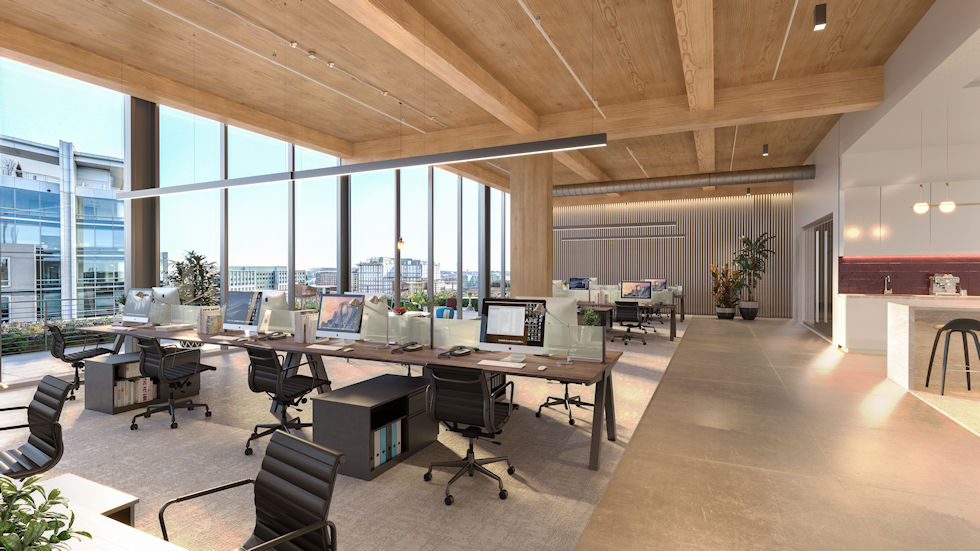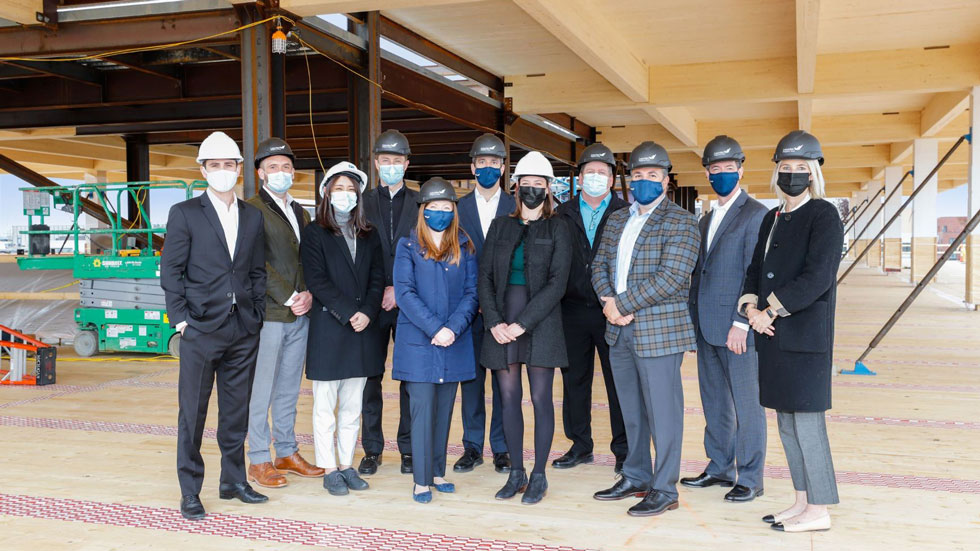When Columbia Property Trust Inc. (NYSE: CXP) wanted to expand an office building in the Navy Yard submarket in Washington, D.C., the REIT was keen to generate excitement for the property and demonstrate its commitment to sustainability. The company turned to one of the world's oldest building materials—wood—to achieve both.
Nelson Mills, president and CEO of Columbia Property Trust, says the Navy Yard submarket has exploded with residential and commercial demand, "so we knew we needed to do something unique when we were ready to update and expand the building."
Working with architectural design firm Hickok Cole, Columbia Property Trust landed on mass timber as the solution to meet its ESG goals and to enable a biophilic design, which connects occupants to the natural environment, to attract potential tenants. Mass timber is comprised of compressed layers of wood that are glued together, which provide exceptional strength and stability.
Mass timber design is considered to be a low-carbon alternative to traditional steel, concrete, and masonry building materials and allows for increases in height with minimal impact on the overall structure. The use of mass timber to add two floors and a penthouse amenity space to the Columbia Property Trust building at 80 M St. SE provides the opportunity for 15-foot-high ceilings, 12-foot-high windows, and 50% more volume of light and air compared to a similarly sized concrete-and-steel addition, says Patrick Keeley, senior vice president and D.C. region lead for Columbia Property Trust. The expansion is expected to be completed in 2022.
"The design allows for two times as much light to penetrate the interior of the building, which in turn offers biophilic benefits that make employees feel better in the space," Keeley says.
Being the first commercial office construction project to use mass timber in the D.C. market meant taking on risk, Mills says, so pre-leasing 50% of the addition to the American Trucking Associations was part of the equation that made the project work. "We made a tradeoff to create a unique building," Keeley says. "If we used concrete, we would have had more rentable square feet, but it would have been more of a commodity product instead of a cutting-edge building."
At the same time, timber's light weight saves money on the construction process, Keeley says.
"If we chose concrete, we would have needed to reinforce all the columns in the building, but with mass timber we only had to reinforce four columns," he says. "That also meant a lot less disruption to the tenants since the building has stayed occupied throughout construction."
New Heights
While wood has been used for centuries to construct buildings, the technology for mass timber was developed about 20 years ago, says Bill Parsons, vice president of operations for WoodWorks—the Wood Products Council.
Parsons explains that the 2021 International Building Code allows mass timber buildings of up to 18 stories, which has expanded architectural options beyond the five or six-story limits of earlier codes.
For Columbia Property Trust and Hickok Cole, mass timber fits in with their ideals of designing and building sustainable buildings, as well as their financial goals.
"When you compare the options for high-rise construction between concrete, steel, and timber, mass timber is the only renewable resource among them," says Tom Corrado, a senior associate with Hickok Cole and senior designer for 80 M St. SE.
Not only is mass timber a renewable resource, but it embeds carbon rather than produces it, adds Jason Wright, an associate principal with Hickok Cole and senior project manager for 80 M St. SE. In addition, the production of mass timber provides the timber industry with a new revenue stream, he says.
"Wood is the only building material that meets all 17 of the United Nation's criteria for sustainable development," says Melissa Kroskey, technical director for WoodWorks. "For companies looking to reduce their carbon footprint, wood absorbs carbon and stores it for the lifetime of the building. The light weight of timber gives builders the ability to increase vertical density while lowering their carbon footprint."
Wood for mass timber is largely sourced in North America from short growth trees such as pine and fir that grow in 20 years, Corrado explains. "The timber companies are responsible stewards of the forest and their harvesting practices help regenerate the soil," he says. "The total embodied energy it takes to produce a mass timber panel is less than what it takes to produce concrete and steel, so you're offsetting your carbon footprint from the very beginning."
Mass timber also offers a market incentive for timber companies to remove wood that has been damaged by fire and insects, which in turn reduces wildfire risk, Kroskey says.
"Mass timber has a future second life, too, because if the building was ever replaced the wood could be repurposed for another building," Corrado notes.
Benefits and Challenges
Building with mass timber is 30% faster than with concrete, Parsons says, because there is no need for shoring and reshoring of the building while you wait for concrete to cure. Case studies researched by WoodWorks also found positive financial performance from mass timber buildings.
"Developers benefit from better leasing velocity because tenants are attracted by the hip, cool, authentic environment of these buildings," Kroskey says. "A lot of companies, especially big tech companies, are interested in the benefits of biophilic design, including increased productivity."
Mass timber is increasingly popular in Europe and is growing in use across the United States, Parsons says.
"The main challenge is just educating architects and engineers to help them understand how to build with mass timber," Parsons says. "Each jurisdiction has to adopt the 2021 building code that expands the height restrictions on mass timber buildings. Some places are still working under a 2009 code."
Some states and cities have been early adopters of the 2021 code, Parsons says, especially tall wood buildings. He says about 100 mass timber buildings are constructed each year in the U.S.
"The D.C. government is one of the most progressive on sustainability and green technology, so 80 M was an opportunity for us to bring in a real project and work with the city on updating the code," Wright says.
Builders, architects, and insurance companies need education about how resilient mass timber buildings can be, Kroskey says. For example, fire protection is incorporated into the boards when the mass timber is produced. Mass timber is also durable and resilient to earthquakes and storm damage.
More Supply Needed
As for pricing, "the cost of mass timber depends on the supply chain, so at the moment there's lots of choppiness as building and renovations ramp up," Parsons says. "But overall, builders save money when they use mass timber because of the shorter construction time. They also save time because they don't need to do finishing work when the wood is left exposed."
While the use of mass timber is anticipated to expand, more supply is needed to bring costs down. Wright says that very little mass timber is harvested east of the Mississippi today, so expanding the industry could bring down prices.
"We planned this project and locked in the timber prices before the pandemic," Keeley says. "If we were pricing this today it would be at least twice as expensive. But the cost of materials is increasing across the board and we definitely anticipate using mass timber in other projects in the gateway cities where we operate."
Companies need to understand that they won't be losing money if they choose to emphasize their ESG goals and use mass timber, Parsons says. "The case is really strong that mass timber can be a good way to differentiate themselves whether they're building multifamily buildings, student housing or offices," he adds.


